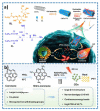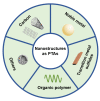Nanostructures as Photothermal Agents in Tumor Treatment
- PMID: 36615470
- PMCID: PMC9822183
- DOI: 10.3390/molecules28010277
Nanostructures as Photothermal Agents in Tumor Treatment
Abstract
Traditional methods of tumor treatment such as surgical resection, chemotherapy, and radiation therapy have certain limitations, and their treatment effects are not always satisfactory. As a new tumor treatment method, photothermal therapy based on nanostructures has attracted the attention of researchers due to its characteristics of minimally invasive, low side effects, and inhibition of cancer metastasis. In recent years, there has been a variety of inorganic or organic nanostructures used in the field of photothermal tumor treatment, and they have shown great application prospects. In this paper, the advantages and disadvantages of a variety of nanomaterials/nanostructures as photothermal agents (PTAs) for photothermal therapy as well as their research progress are reviewed. For the sake of clarity, the recently reported nanomaterials/nanostructures for photothermal therapy of tumor are classified into five main categories, i.e., carbon nanostructures, noble metal nanostructures, transition metal sulfides, organic polymer, and other nanostructures. In addition, future perspectives or challenges in the related field are discussed.
Keywords: nanomaterials; nanostructures; photothermal agents; photothermal therapy; tumor.
Conflict of interest statement
The authors declare no conflict of interest.
Figures







Similar articles
-
Recent advances in nanomaterials for enhanced photothermal therapy of tumors.Nanoscale. 2018 Dec 13;10(48):22657-22672. doi: 10.1039/c8nr07627h. Nanoscale. 2018. PMID: 30500042 Review.
-
Nanomaterials for photohyperthermia: a review.Curr Pharm Des. 2013;19(37):6622-34. doi: 10.2174/1381612811319370006. Curr Pharm Des. 2013. PMID: 23621537 Review.
-
Recent advances in functional nanostructures as cancer photothermal therapy.Int J Nanomedicine. 2018 May 17;13:2897-2906. doi: 10.2147/IJN.S161031. eCollection 2018. Int J Nanomedicine. 2018. PMID: 29844672 Free PMC article. Review.
-
Two-Dimensional Nanomaterials for Photothermal Therapy.Angew Chem Int Ed Engl. 2020 Apr 6;59(15):5890-5900. doi: 10.1002/anie.201911477. Epub 2020 Feb 4. Angew Chem Int Ed Engl. 2020. PMID: 32017308 Review.
-
Near-infrared inorganic nanomaterial-based nanosystems for photothermal therapy.Nanoscale. 2021 May 20;13(19):8751-8772. doi: 10.1039/d1nr00323b. Nanoscale. 2021. PMID: 33973616 Review.
Cited by
-
PLGA and PDMS-based in situ forming implants loaded with rosuvastatin and copper-selenium nanoparticles: a promising dual-effect formulation with augmented antimicrobial and cytotoxic activity in breast cancer cells.Front Pharmacol. 2024 Jun 4;15:1397639. doi: 10.3389/fphar.2024.1397639. eCollection 2024. Front Pharmacol. 2024. PMID: 38895619 Free PMC article.
-
Recent advances in nano-molybdenum oxide for photothermal cancer therapy.Nanomedicine (Lond). 2025 Apr;20(8):883-901. doi: 10.1080/17435889.2025.2476386. Epub 2025 Mar 10. Nanomedicine (Lond). 2025. PMID: 40063363 Review.
-
The Therapeutic Effects of MUC1-C shRNA@Fe3O4 Magnetic Nanoparticles in Alternating Magnetic Fields on Triple-Negative Breast Cancer.Int J Nanomedicine. 2023 Oct 6;18:5651-5670. doi: 10.2147/IJN.S426849. eCollection 2023. Int J Nanomedicine. 2023. PMID: 37822991 Free PMC article.
-
Application and development of nanomaterials in the diagnosis and treatment of esophageal cancer.Front Bioeng Biotechnol. 2023 Nov 3;11:1268454. doi: 10.3389/fbioe.2023.1268454. eCollection 2023. Front Bioeng Biotechnol. 2023. PMID: 38026877 Free PMC article. Review.
-
The clinical prospects and challenges of photothermal nanomaterials in myocardium recovery after myocardial infarction.Front Bioeng Biotechnol. 2024 Oct 29;12:1491581. doi: 10.3389/fbioe.2024.1491581. eCollection 2024. Front Bioeng Biotechnol. 2024. PMID: 39539693 Free PMC article. Review.
References
Publication types
MeSH terms
Substances
Grants and funding
LinkOut - more resources
Full Text Sources
Medical
Research Materials

